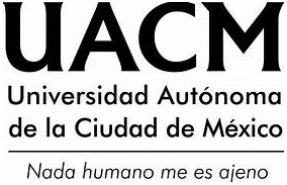ART, ETHICS, AND SOCIALIZATION: A WAY OF UNDERSTANDING PRAGMATIC AESTHETIC IN POSTMODERN COORDINATES
DOI:
https://doi.org/10.29092/uacm.v5i9.189Keywords:
Pragmatic aesthetic, arts, ethics, socialization, dialogueAbstract
This article presents a reflexion on the social function of contemporary artistic practices. The work takes, initially, a position on postmodernism and also reviews the principal philosophical positions that allow us to assert a pragmatic proposal about the aesthetic proposal. By means of the critical analysis of these proposals, the author indicates the aspects that could be taken into account to elaborate a view that allows us to think about the inmanent relations between art and ethics, which is oriented in this work through the concepts of “dialogue”, “knowledge” and “aesthetic experience”.
Downloads
References
BATESON, G. y J. Ruesch (1984), Comunicación. La matriz social de la psiquiatría. Barcelona: Paidós.
BEUCHOT, M. (2005), “Hermenéutica analógica y crisis de la modernidad”. Artículo en línea disponible en www.uaem.mx/oferta/facultad/ humanidades/filos/Beuchot-Herme.htm, enero de 2007.
BOURDIEU, P. (1988), La distinción. Criterios y bases sociales del gusto. Madrid: Taurus.
-------(1990), Sociología y cultura. México: Fondo de Cultura Económica, México.
-------(1995), Las reglas del arte: génesis y estructura del campo literario. Barcelona: Anagrama.
BRUNER, J. (1991), Actos de significado. Más allá de la revolución cognitiva. Madrid: Alianza Editorial.
-------(2001), Realidad mental y mundos posibles. Los actos de la imaginación que dan sentido a la experiencia. Barcelona: Gedisa.
CHARTIER, R. (2000), Entre poder y placer. Cultura escrita y literatura en la Edad Moderna. Madrid: Cátedra.
DANTO, A. (1981), The Transfiguration of the Commonplace. Cam- bridge: Harvard University Press.
-------(2003), “Arte y significado”, en La Madonna del futuro. Ensayos en un mundo del arte plural. Barcelona: Paidós.
FOLLARI, R. (1990), Modernidad y postmodernidad: una óptica desde América Latina. Buenos Aires: Aique/Rei/Ideas.
GOODMAN, N. (1976), Los lenguajes del arte. Barcelona: Seix Barral. (1990), Maneras de hacer mundos. Madrid: Visor.
GOUTMAN, A. (1994), “Comunicación Estética”, en Plural, no. 279. Revista cultural de Excelsior, diciembre. México, pp. 58-61.
GUMBRECHT, H. U. (1997), “Consecuencia de la Estética de la recepción o: la Ciencia literaria como Sociología de la Comunicación”, en José Antonio Mayoral, Estética de la Recepción. Madrid: Arco, pp. 145-175.
JAMESON, F. (2005), El postmodernismo o la lógica cultural del capi- talismo tardío. Buenos Aires: Paidós.
JAUSS, H. R. (2002), Pequeña apología de la experiencia estética. Barcelona: Paidós.
LOTMAN, I. (1994), “Para la construcción de una teoría de la interacción de las culturas (el aspecto semiótico)”, en Revista Criterios, núm. 32, Cuarta Época, julio-diciembre, pp. 117-130.
MARCUSE, H. (1983), Eros y Civilización. Madrid: Sarpe.
MEARLEU-PONTY, M (1975), Fenomenología de la percepción. Barcelona: Península.
MORIN, E. (1995), “Epistemología de la complejidad”, en Fried Schnitman, Dora (ed.), Nuevos paradigmas, cultura y subjetividad. México: Paidós, pp. 421-446.
PIAGET, J. (1973), Estudios de psicología genética. Buenos Aires: EMECE.
RICOEUR, P. (1977), La metáfora viva. Buenos Aires: Megalópolis.
-------(1995), Tiempo y narración, vol. II. México: Siglo XXI.
-------(1998), Teoría de la interpretación. México: Siglo XXI.
SCHAEFFER, J. M. (2005), Adiós a la estética. Madrid: Móstoles.
SCHILLER, J. C. F. (1991), “Escritos sobre estética”, en Cartas sobre la educación estética. Madrid: Tecnos, pp. 97-217.
TODOROV, T. (2005), Crítica de la crítica. Barcelona: Paidós.
VARELA, F. J. (2005), Conocer. Barcelona: Gedisa. VILAR, G.
-------(2005), Las razones del arte. Barcelona: La Balsa de la Medusa, Colección Filosofía.
VON GLASSERSFELD, E. (1995), “La construcción del conocimiento”, en Fried Schnitman, Dora (ed.), Nuevos paradigmas, cultura y subjetividad. México: Paidós, pp. 115-141.
WATZLAWICK, P., et al. (1991), Teoría de la comunicación humana. Barcelona: Editorial Herder.
Published
Issue
Section
License
This Journal is licensed under Creative Commons Mexico 2.5. It is allowed to reproduce and disseminate the contents of the Journal for educational or research purposes, not for profit, as long as they are not mutilated and cite the source (Andamios, Revista de Investigación Social) and the author.
The copyright of the articles published in Andamios, Revista de Investigación Social are transferred by the author(s) to Universidad Autónoma de la Ciudad de México when the originals have been accepted, so that they are published and distributed both in the printed and electronic versions of the Journal. However, as established by law, the author(s) retains their moral rights. The author(s) will receive a form of assignment of copyright that they must to sign when their original has been accepted. In the case of collective articles, the signature of one of the authors will suffice, provided that the latter has obtained the consent of the others.
Authors may use the material of their article in other works or books published by themselves, with the condition of quoting Andamios as the original source of the texts.
The articles contained in this publication are the responsibility of their authors and do not compromise the official position of Andamios, Revista de Investigación Social of the Universidad Autónoma de la Ciudad de México.


